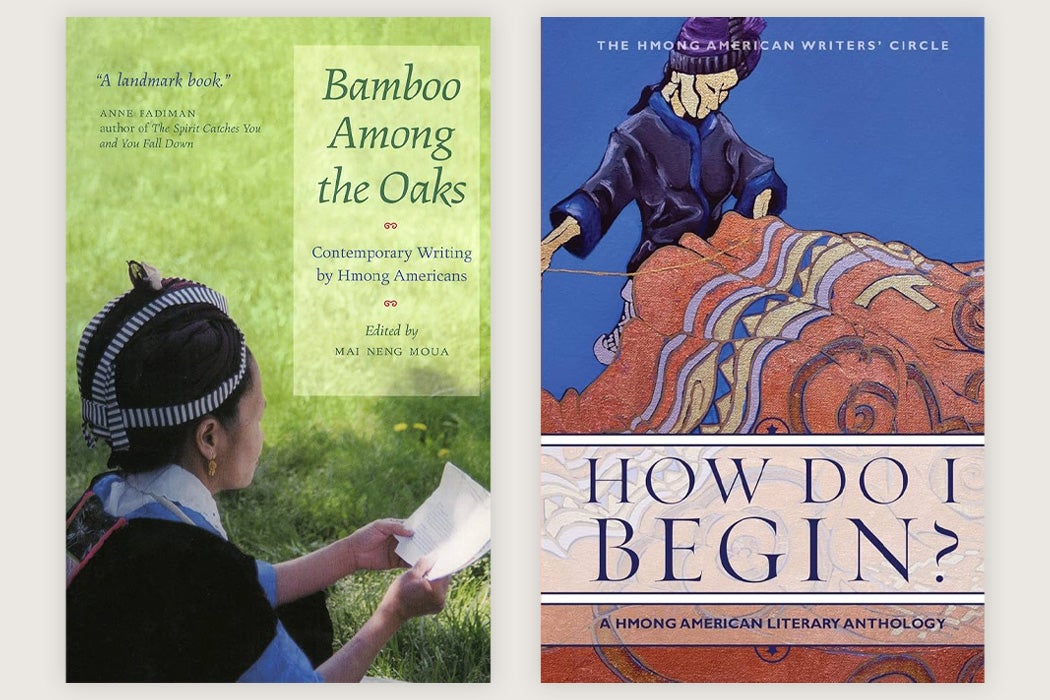They say that home is where the heart is. But placing home can be hard for refugees, especially Hmong American writers, writes historian Ma Vang. Vang suggests that these authors participate in what she calls “writing on the run,” a practice that she teases out through her reading of two collections of Hmong American literature.
Tying historical suppression of Hmong written language with the dispossession of the Hmong people from their homelands, Vang theorizes that refugee flight “establishes Hmong writing as mobile, unhinging literature and subjectivity from the fixity of national and canonical paradigms.”
In 2002, the Minnesota Historical Society Press in St. Paul, a major site of Hmong resettlement, published the anthology Bamboo Among the Oaks: Contemporary Writing by Hmong Americans. Analyzing the included works, Vang finds the theme of running comes to the fore in the poem “Running Away from Home” by the California-based Pa Xiong.
The poem begins:
i’m homeless
didn’t you know?
I never saw my mountains
my jungles, my fields of opium
my home built by my father’s two hands
I left before I was even born.
The loss felt by Hmong Americans who became refugees at a young age and who continue to relive the experience through their parents’ memories echoes through the lines. Moreover, “the poem reflects the refugee’s vexed relationship to home as a deterritorialized subject whose existence challenges the very notion of a past origin and a possible future location that is tied to the nation-state,” Vang explains. The dominant portrayal of refugees presents their resettlement as rejoining the nation-state. But Xiong’s narrator continues to move from town to town, which “suggests that these places are temporary sites from which to leave rather than places to run to.”
Mexican and Asian immigrants have historically settled in California’s Central Valley, forming the backbone of the region’s agricultural labor force. At the time was Vang was writing (2015–16), approximately 47,000 Hmong residents lived in the San Joaquin section of the valley. Some 32,000 of those had settled in Fresno. Vang notes that though the region was producing the highest agribusiness revenues in the US, “its major metropolitan areas rank[ed] among the poorest in the state and the nation as a result of high unemployment rates created by a primarily agricultural economy.”
It was in this context that the Fresno-based Hmong American Writers’ Circle released the 2011 How Do I Begin?: A Hmong American Literary Anthology that depicts “changing meanings of home” in the Central Valley. Vang writes that “Xiong’s description of ‘running away from home’ [also] frames the poems in How Do I Begin? to show how home is a process of moving and running despite living in a place.”
She also points to Andre Yang’s poem “Kingswood Garden Apartment Kid,” which is written from the point of view of a Hmong American girl whose family renames their apartment complex from Kingswood Garden to “Zos Vib Nais, a name she knows is reminiscent / of the refugee camp in Thailand.” The girl and the other children play in the parking lot of their new home, in a way that “conveys the continuous experiences of refugee displacement,” Vang argues.
Weekly Newsletter
“Lines such as ‘the red stain on her shin is the San / Joaquin River in June, a dried run from the / scabs on her knees’ reveal the connection of the body to earth,” Van explains, while “the jump rope metaphor…signifies the circular motion and path of home-making for the deterritorialized refugee subject.”
Vang’s close study of Hmong American writing shows that Hmong literature can shape a collective consciousness that is not limited by ethnicity or nationality, but that focuses on “a layered and ongoing condition of escaping… and creating the conditions of possibility to exist.”
By connecting the acts of running and writing, “Hmong American literary formations, then, can expand how critical refugee studies investigate historical erasure to foreground a critique of power and knowledge from the perspective of peoples who are on the move,” she concludes.







